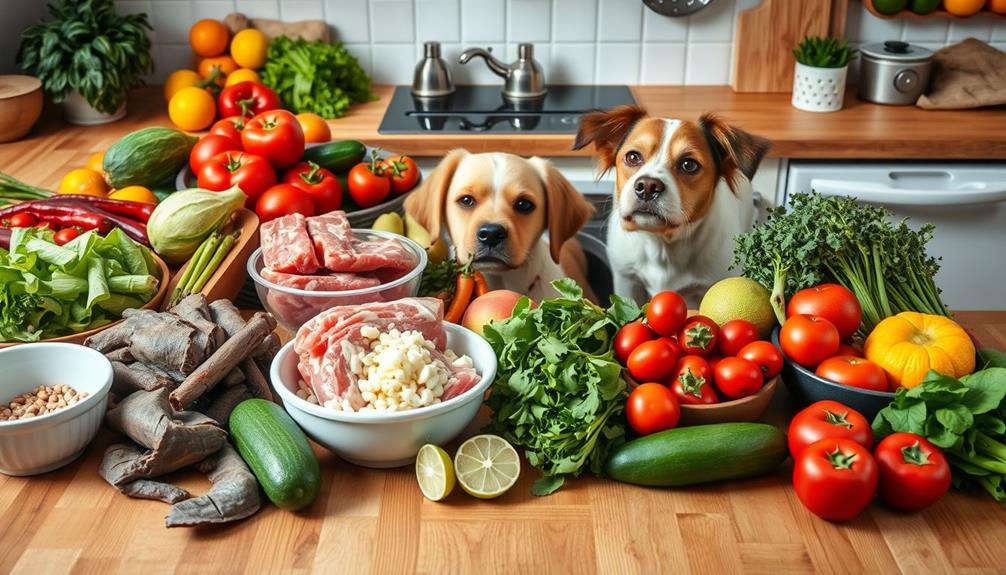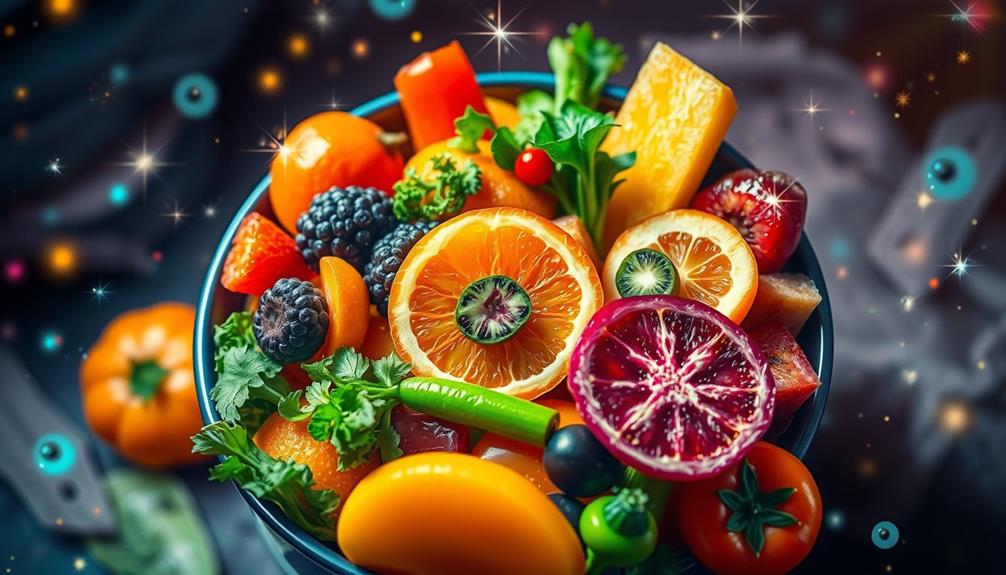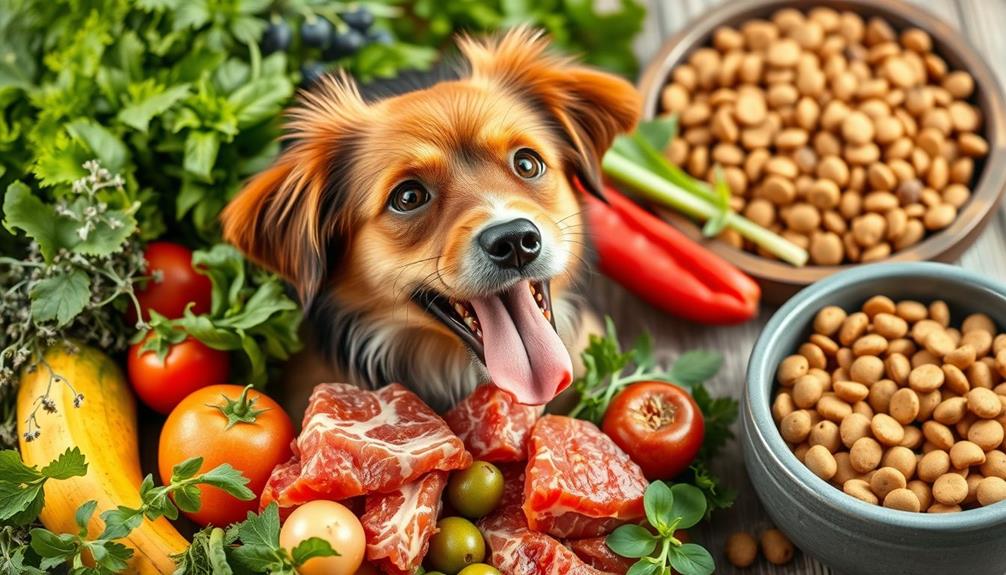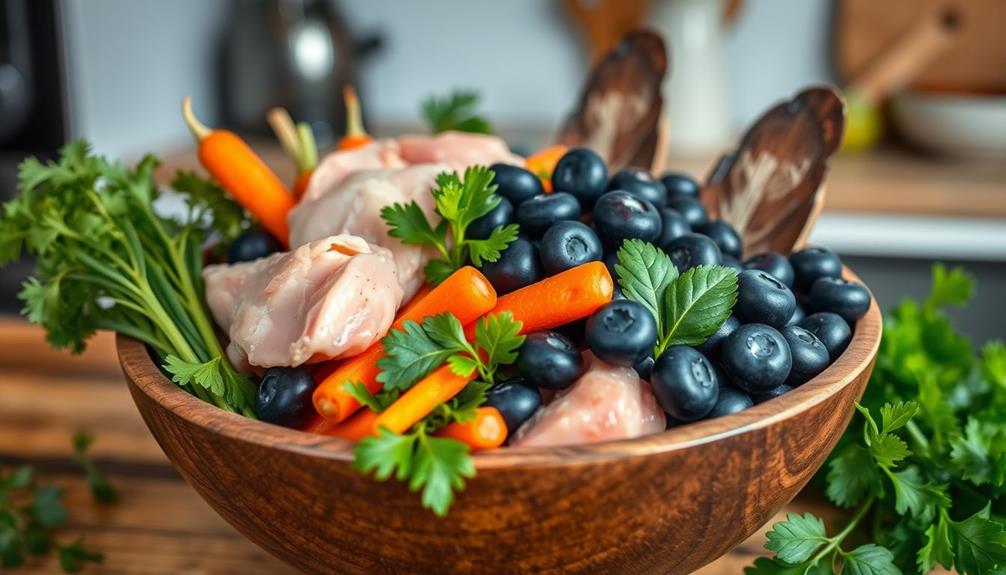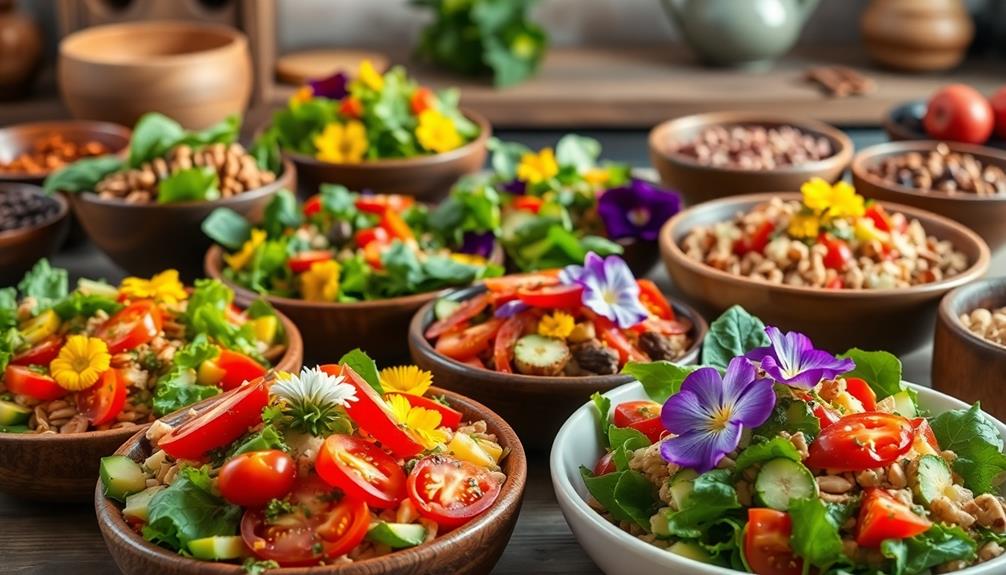To add raw food to your dog's diet, start by mixing 25% raw food with 75% of their current diet for three days. Gradually increase the raw portion to 50% for another three days, then 75% for three more days until they're eating 100% raw by Day 10. Focus on balanced nutrition: include muscle meat (70-80%), organ meats (10-20%), and raw meaty bones (10-15%). Use high-quality ingredients and source from reputable suppliers. Monitor your dog's response and adjust as necessary. This approach can boost your dog's overall health, and there's more to evaluate for a successful shift. When introducing raw food for your dog, it’s important to also consider any potential dietary sensitivities or allergies they may have. Keep an eye out for any changes in their stool, coat, energy levels, and overall demeanor as you make the transition. Consulting with a veterinarian or a canine nutritionist can also provide valuable guidance in ensuring a smooth and successful shift to raw food for your dog.
Key Takeaways
- Begin by introducing raw food gradually, starting with 25% raw and 75% old diet for the first three days.
- Increase the raw food ratio to 50% for the next three days, monitoring your dog's digestion.
- Adjust to 75% raw and 25% old diet before fully transitioning to 100% raw by Day 10.
- Observe for any digestive upset during the transition; extend the adaptation period if necessary.
- Aim to feed 2-5% of your dog's body weight in raw food, adjusting for activity level.
Understanding Raw Dog Food
Understanding raw dog food is fundamental if you're considering this diet for your furry friend. This diet consists of uncooked muscle meat, organ meats, and bones, often complemented with fruits and vegetables. To maintain a balanced raw diet, it's essential to include the right proportions of these components; otherwise, your dog could face nutritional deficiencies. Additionally, incorporating nutritional guidelines can help guarantee your dog receives all necessary nutrients.
Dogs' digestive systems are designed to handle raw meat, thanks to their strong stomach acid and digestive enzymes. This means cooking isn't necessary for them to thrive. The raw diet mimics the natural eating habits of wild canines, promoting better digestion and overall health.
If you're unsure about how to achieve a balanced raw diet, companies like We Feed Raw offer pre-formulated meals that meet nutritional guidelines crafted by PhD animal nutritionists. These meals guarantee your dog receives the necessary nutrients for peak health without the guesswork.
Changing to raw dog food can be a rewarding choice for both you and your pet, but understanding its components is the first step in making this significant dietary shift.
Benefits of a Raw Diet

Switching to a raw diet can lead to noticeable health improvements for your dog.
You might see enhanced vigor and energy levels, thanks to the rich nutrients found in fresh meats and organs. Additionally, the natural ingredients help support better digestion and overall well-being.
Furthermore, similar to how a diet rich in antioxidants, such as cranberry juice consumption, can benefit humans, fresh ingredients in your dog's diet can also provide essential nutrients that promote a healthier lifestyle.
Health Improvements Overview
Adopting a raw food diet for your dog can lead to significant health improvements that enhance their overall well-being.
When you switch to a dog's raw diet, you'll notice various health benefits that contribute to a healthier, happier pet. For instance, incorporating natural ingredients like healthy dog snacks can further enhance your dog's nutrition profile.
Here are four key improvements:
- Improved Digestion: A raw food diet promotes better nutrient absorption, resulting in smaller, firmer stools and less waste compared to traditional kibble.
- Skin and Coat Health: The natural fats and moisture in raw food help maintain a shiny coat and reduce issues like dry skin and excessive shedding.
- Weight Control: By eliminating indigestible carbohydrates found in processed foods, a raw diet supports a healthy body condition, making it easier to manage your dog's weight.
- Dental Health: The natural enzymes in raw food can reduce plaque buildup and promote fresher breath, thanks to the chewing of raw bones and meat.
With these improvements, you'll likely see enhanced energy and vigor levels in your dog, along with reduced allergy symptoms.
Shifting to a nutritionally balanced raw food diet can truly transform your pet's health for the better.
Enhanced Vitality Insights
The benefits of a raw food diet extend beyond just health improvements, leading to enhanced vigor and energy in your dog. Many dog owners notice increased energy levels in their pets after switching to a raw diet, which is largely due to improved digestion and nutrient absorption. This change allows your dog to utilize nutrients more effectively, boosting overall liveliness.
Additionally, incorporating raw foods can lead to better hydration, as fresh meats and veggies contain more moisture compared to dry kibble, which aligns with proper hamster care and costs principles of providing a balanced diet.
Moreover, a raw diet contributes to healthier skin and a shinier coat, as it provides essential moisture and healthy fats. You might also see significant improvements in dental health; natural chewing on bones helps reduce plaque and tartar buildup, promoting a cleaner mouth.
With smaller, firmer stools, you'll notice less waste production—an indicator of better digestion and nutrient utilization. Additionally, shifting to a raw diet can lead to reduced allergies and improved immune function, enhancing your dog's overall quality of life.
Safety and Quality Measures
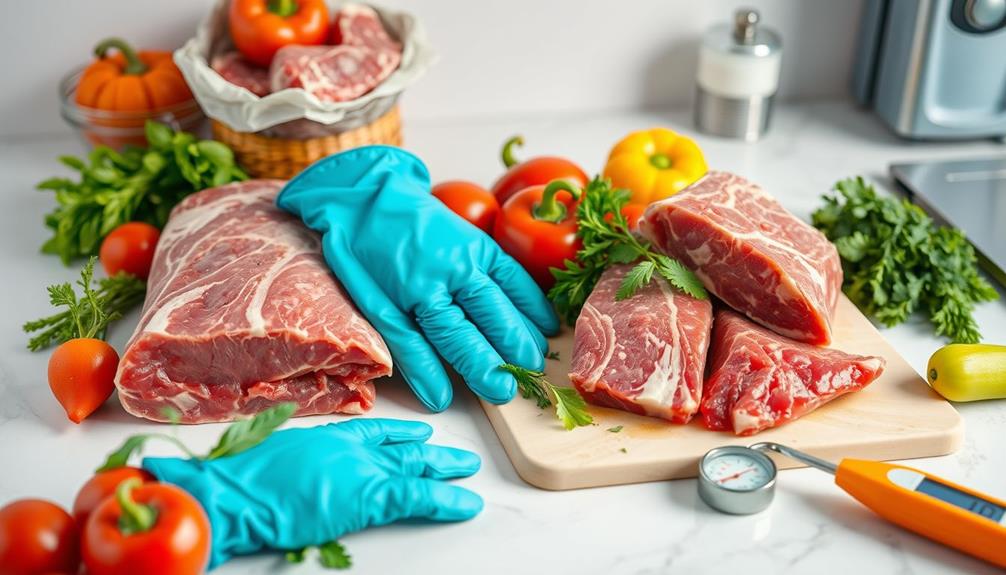
Maintaining safety and quality in your dog's raw food diet is essential for their health. To minimize contamination risks and guarantee your dog receives the best nutrition, follow these safety precautions:
- Source from reputable suppliers: Choose raw food made from USDA-certified human-grade ingredients to reduce contamination risks. Additionally, consider the benefits of incorporating ingredients like glycolic acid for skin benefits that may enhance overall wellness.
- Safe handling practices: Always wash your hands and surfaces thoroughly after handling raw meat to prevent the spread of bacteria like Salmonella.
- Utilize High-Pressure Processing (HPP): This method effectively eliminates harmful pathogens without compromising the food's nutritional integrity.
- Store at proper temperatures: Keep raw food frozen until you're ready to use it. Always defrost it in the refrigerator to maintain safety.
Additionally, it's vital to regularly consult with your vet. They can help monitor your dog's health and adjust their diet to meet their specific nutritional needs, guaranteeing you adhere to safety standards.
Transitioning to Raw Food
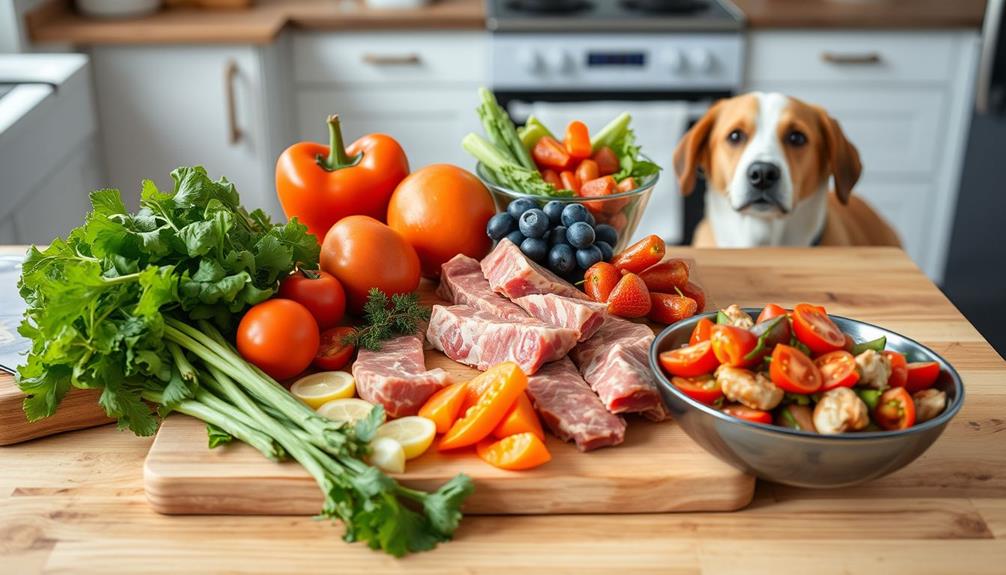
Shifting your dog to a raw food diet can be a rewarding journey, but it requires careful planning and patience. Start by mixing 25% raw food with 75% of your dog's current diet for the first three days. Gradually increase the raw food portion to 50% for the next three days.
Next, adjust to 75% raw food and 25% old diet for another three days before fully switching to a 100% raw diet by Day 10. During this changeover, it's crucial to monitor your dog for any signs of digestive upset. If issues arise, slow down the process and allow for a longer adaptation period.
The recommended feeding amount during this changeover is 2-5% of your dog's body weight in raw food, depending on their activity level and health needs. Keeping a food journal is beneficial to track changes in weight and health, enabling you to identify necessary adjustments.
Here's a quick reference table for the changeover:
| Day Range | Raw Food % | Old Diet % |
|---|---|---|
| Days 1-3 | 25% | 75% |
| Days 4-6 | 50% | 50% |
| Days 7-10 | 100% | 0% |
Choosing Raw Food Options
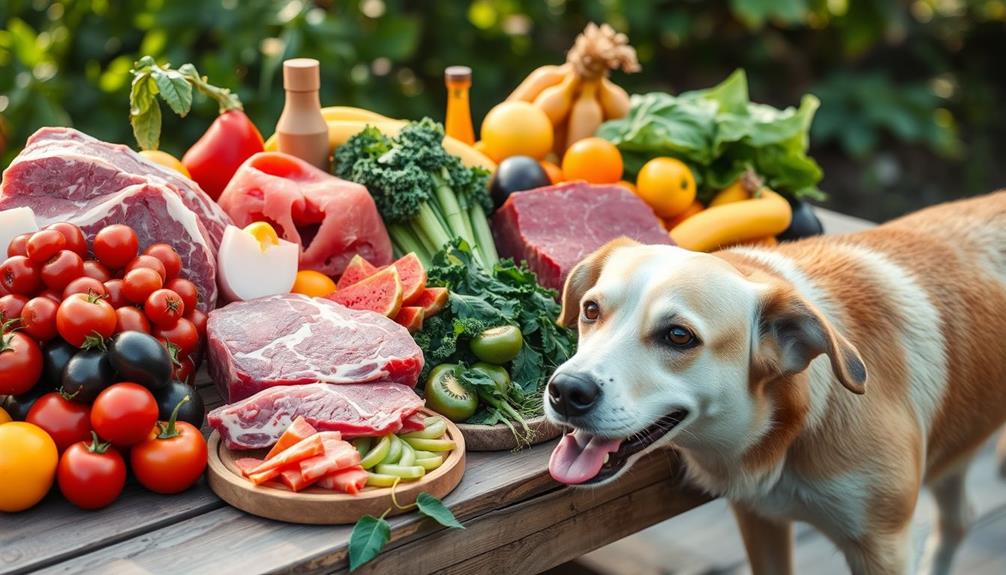
When you're choosing raw food options for your dog, it's essential to prioritize their nutritional requirements.
Consider researching the benefits of diversification in their diet by incorporating various protein sources such as chicken, beef, and fish.
Make sure the ingredients you select are high-quality and meet the guidelines set by AAFCO.
Nutritional Requirements Overview
Choosing the right raw food options for your dog is crucial for their health and well-being. To guarantee balanced nutrition, you'll need to include various components that meet their dietary needs.
It's important to research different raw food providers thoroughly to avoid any potential scams, verifying they're reputable and compliant with regulations, similar to how one would approach avoiding Gold IRA scams.
Here's a quick guide:
- Muscle Meat: Make this the foundation of your dog's diet, providing high-quality proteins that are essential for growth and energy.
- Organ Meats: Aim for 10-20% of the diet from organ meats. These are packed with important nutrients that support overall health.
- Raw Meaty Bones: Include 10-15% raw meaty bones to meet calcium requirements. This helps prevent deficiencies and promotes strong bones.
- Vegetables and Fruits: Incorporate 10-20% of blended or finely chopped vegetables and fruits. These add fiber and additional nutrients for a well-rounded diet.
Selecting Quality Ingredients
To keep your dog healthy and thriving, selecting quality ingredients for their raw food diet is key. Start by prioritizing fresh meats that are free from additives, and consider enhancing their diet with natural supplements such as essential oils for health to support their overall well-being. Always source these from reputable suppliers to guarantee high quality and safety.
Incorporating a variety of protein sources, including organ meats like liver and heart, will help create a balanced nutrient profile essential for your dog's health.
Don't forget about raw meaty bones (RMBs), such as chicken necks or lamb ribs, which are excellent sources of calcium and phosphorus necessary for strong bones and teeth. Avoid processed meats that contain fillers and preservatives, as these can lead to nutritional imbalances and health issues for your dog.
When selecting raw food products, look for those that are AAFCO-compliant. This certification guarantees the food meets established nutritional standards for complete and balanced canine diets.
Nutritional Balance Essentials
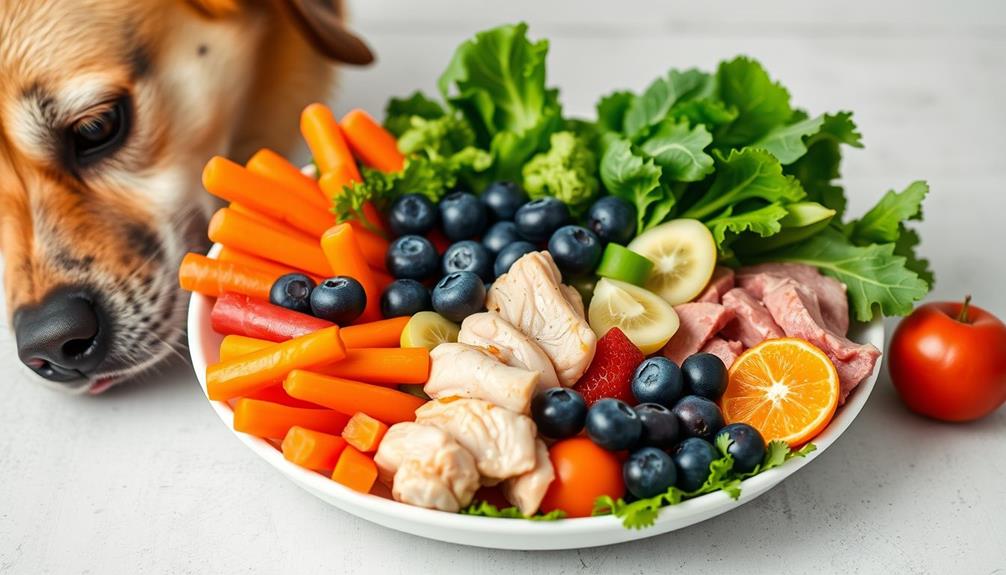
Achieving nutritional balance is vital for your dog's health, especially when incorporating raw food into their diet. A balanced raw diet mimics the composition of a prey animal, guaranteeing your pup receives the right nutrients to thrive.
Incorporating a variety of food sources is key to this balance, as it helps to prevent nutritional deficiencies and promotes overall wellness. Here are key components to focus on:
- Muscle Meat: Aim for 70-80% of the diet to consist of high-quality muscle meat. This provides the primary protein sources your dog needs for energy and muscle maintenance.
- Bone: Include 10-15% bone to supply calcium and phosphorus, essential for bone health.
- Organ Meats: Incorporate 10-20% organ meats, particularly liver, which serves as a natural multivitamin packed with essential vitamins and minerals.
- Essential Fatty Acids: Balance omega-3s and omega-6s to promote healthy skin and reduce inflammation. Salmon is a great source of omega-3s.
Additionally, regular check-ups to monitor your dog's overall health can help guarantee that their diet remains balanced and effective for their needs. monitor kidney function
Frequently Asked Questions
How Do I Incorporate Fresh Food Into My Dog's Diet?
To incorporate fresh food into your dog's diet, start with a small portion, about 20% of their daily intake. Adjust their regular food accordingly, and monitor how they respond to these new additions.
Conclusion
Incorporating raw food into your dog's diet can be a rewarding journey, like opening a treasure chest of vibrant health and energy. As you guide your furry friend toward this nourishing path, remember to take it slow and steady, ensuring each step is filled with care and consideration. With the right choices and a sprinkle of patience, you'll watch your pup flourish, wagging their tail in delight as they embrace their new, wholesome meals.

